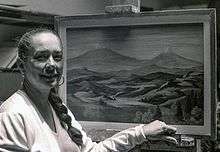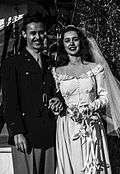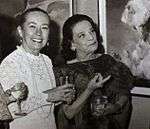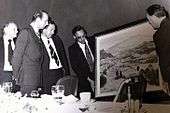Martha Joy Gottfried
| Martha Joy Gottfried | |
|---|---|
 Martha Joy in 1995. | |
| Born |
Martha Joy Young September 15, 1925 Glendale, Arizona, U.S. |
| Died |
January 10, 2014 (aged 88) Coyoacán, Mexico City, Mexico |
| Nationality | Mexican |
| Education | San Carlos Academy |
| Known for | Painting |
Martha Joy Gottfried (Born Martha Joy Young; September 15, 1925, Glendale, Arizona,[1] – January 10, 2014,[2][3] Coyoacán, México) was a prominent landscape painter.
Biography

Martha Joy was born on September 15, 1925,[4] in Glendale, Arizona, to Samuel Joy and Helen Young. She was the oldest of four children: Mariam, Helen and Samuel. As a child she showed a natural inclination for painting and, according to an interview, "her earliest mentor was her father, a rancher by trade, through whose eyes she learnt [sic?] to appreciate the scenic beauty that surrounded her."[1]

While attending Stephens College for women in Columbia, Missouri,[1][4] she met her husband, Mario Héctor Gottfried, a pilot of the U.S. Army Air Corps.[5] Soon thereafter, the two were married on January 29, 1945, in a Methodist church in Glendale, Arizona.
Due to the duties of her husband, Martha & Mario lived in the United States before moving to Mexico City in 1945.[6] They were married for more than 55 years, most of which were spent at their home in Coyoacán.[7] Their four children, Mario Héctor, Maria Elena, Carlos Federico and Martha Cecilia were raised there.
As a young mother in Mexico, she used drafts or watercolors as techniques.[8] Later, surrounded by an environment of famous artists and talented friends, she developed her art methods and became partisan of landscape paintings in oil and egg tempera.[8]

She took lessons with Martha Sauer (1953–1954) and Gordon D. Jones (1955–1956).[8] Subsequently, she entered the Academia de San Carlos (Academy of San Carlos),[8][9] from 1958 through 1959,[4] in Mexico City, Mexico. The sculptor Ignacio Asúnsolo was also one of her teachers during this period.
Over the years, she continued learning from other well-known artists, among them: Irene de Bohus[8][9] (1959–1962), Toby Joysmith[8] (1962–1963) and Juan O'Gorman[8] (1963–1965), who shared his tempera techniques with her. Eventually, Martha Joy highlighted her own style and special vision of the Mexican natural environment through landscape.
In 1974, she presented her first individual exhibition at a gallery in the Mexican-American Institute of Cultural Relations in Mexico City.[4] In the ensuing years, she held many other exhibitions, including at Instituto Anglo-Americano de Cultura;[10] Polyforum Cultural Siqueiros (1983);[1] Palacio de Minería("Palace of Mining") (1992)[11] and Museo de la Estampa ("Museum of Graphic Arts") (1994). She also held Art and Culture exhibitions at the México City and Cancún, Quintana Roo Airports.[12] In 2004, she exhibited at Palacio de la Escuela de Medicina ("Medical School Palace")[13] and in 2007 at the Club de Industriales("Industrial Club"), in Polanco. Besides her numerous exhibitions in and out of México,[14] many of her paintings have been auctioned around the world.[15]


Some of her works were acquired by distinguished institutions and notable persons.[16] Among others, during an honorary ceremony held in México City's Iztapalapa in 1976, she presented a painting of the Valley of Mexico to José López Portillo,[17][18] who at the time was a presidential candidate. In December 1978, the Duke of Kent received one of her paintings in a ceremony held by the British Chamber of Commerce in Mexico.[17][18][19]
Martha Joy is known as a painter with an extensive artistic production. It was estimated that she created around 700 paintings during the period 1969–1979.[17][18]
Much of her life was devoted to teaching in her own studio.[8][20]
After a long fight with chronic kidney disease, she died of a heart stoppage on January 10, 2014, at the age of 88[2] in Mexico City.
Pictorial work
Considered realistic-modern art,[17][18] Martha's work is inspired by light, weather and natural beauty in various places, such as Arizona, Himalayas and, particularly, Mexico.[6][8] Her production is vast and punctuated by a strong interest in mountain ranges, deserts and majestic Mexican volcanoes, like the Iztaccihuatl and Popocatepetl, located in Central Mexico. In the words of the painter:
%2C_por_Martha_Joy_Gottfried.jpg)
"Distance, light, color, and vivid effect of these elements on a flat surface with pigments, is a continuous and enjoyable challenge. I try to capture the atmosphere of the places that I consider beautiful: mountains and deserts of Mexico are themes that I explore through my painting; its rugged and difficult terrain, the beauty of the shapes and textures of the earth, changes in color and light, as well as shadows, are a great subject for painters (to) enjoy during their lifetime."[18][21]
_(1995)%2C_por_Martha_Joy_Gottfried.jpg)
%2C_por_Martha_Joy_Gottfried.jpg)
Constant motifs in her paintings, such as Topilejo or the Valley of Mexico, are always shown in different seasons or perspectives.[8] This inclination for exploring all the possibilities in landscapes, along with her many trips, whether by sea land or air, led the press to call her "painter of all seasons".[22] During some years she was especially interested in making "skyscapes ... landscapes viewed from an airplane".[22] She commonly used the "Ruben's technique" to paint,[8] "a monochrome oil sketch is done on canvas while on location and back in the studio details can be filled in".[8]
%2C_por_Martha_Joy_Gottfried.jpg)
_por_Martha_Joy_Gottfried.jpg)
Her work, which includes hundreds of paintings and large-scale pieces, is significant to many art critics because, besides showing interesting ecological changes,[6] it presents "factual responses to the natural scene".[23] In this regard, Toby Joysmith states:
"They present no intellectual problems, nor concepts, nor searching. They are effortless to look at. Direct transcription, devoid of transformation, will always give the pure pleasure of recognition, as these paintings most certainly do."[23]
Example of representative works
- 1980: San Miguel de Allende
- 1987: North of Cave Creek
- 1987: Topilejo
- 1989: Iztaccíhuatl summer
- 1990: Urban sprawl
- 1991: From Sierra Chincua
- 1992: Popo & Izta
- 1992: Ajusco
- 1994: The Cliff
- 1994: Road to Yautepec
- 1994: Copper Canyon
- 1994: Fly by Popo
- 1994: Aerial of Anáhuac
- 1994: Zitácuaro Valley
- 1995: Valley of South Mexico II
- 1995: The Superstitions, Arizona
- 1995: Donato Guerra
- 1995: Autumn Sonnet (Grand Topilejo)
- 1997: Popocatépetl & Iztaccíhuatl
- 1997: Read Home(Topilejo)
- 1997: Red Cliff
- 2000: Valle de Bravo lake
- 2004: Pinacate
- 2008: Nevado de Toluca
- 2009: Xitle
See also
References
- 1 2 3 4 "Polyforum shows Gottfried landscapes". The News. México City. 1983-04-16. p. 17.
- 1 2 Mayer, Chistian (January 11, 2014). "Maestra Martha Joy Vda. de Gottfried". Reforma (print edition). Section: City. p. 4.
- ↑ The News. Mexico City. 13 January 2014. p. 5. Missing or empty
|title=(help) - 1 2 3 4 "Martha Joy Gottfried". Clara. Database of women artists. 2008–2012. Retrieved May 22, 2014.
- ↑ Air Force Fifty (Air Force Association ed.). Turner Publishing Company. 1998. p. 158. ISBN 9781563114090.
- 1 2 3 Teracena, Berta (April 1, 1986). "Moléculas interrelacionadas". Hispano Americano. 99. p. 50. Retrieved June 2, 2014.
- ↑ Reilly, Richard (May 14, 1978). "Gottfried stands the true test". The San Diego Union. p. E-4.
- 1 2 3 4 5 6 7 8 9 10 11 12 Hallenbeck, Lulu (October 31, 1981). "Martha Gottfried". The News. Mexico City. p. 26.
- 1 2 ""Paisajes de México" de Martha joy Gottfried". El Heraldo de México. November 23, 1980.
- ↑ "Community News". The News. Mexico City. September 23, 1977. p. 12.
- ↑ "Unknown". Hispano americano. 99 (=2592–2604). 1992. p. 54. Retrieved May 22, 2014.
- ↑ Consejo Nacional para la Cultura y las Artes (México), Instituto Nacional de Bellas Artes (Mexico), Museo Nacional de la Estampa (México City, México). (1994). El arte y la cultura en los aeropuertos de México. p. 33.
- ↑ "Obra plástica de Martha Joy Gottfried". Universidad Nacional Autónoma de México- Facultad de Medicina-Palacio de la Escuela de Medicina. October–December 2004. p. 32.
- ↑ Valencia, Lourdes (October 9, 1979). "Martha Joy Gottfried expone el paisaje mexicano en 40 óleos". El Universal. Section: social. p. 8.
- ↑ Arcadja Auctions Results (2004–2013). "Martha Joy Gottfried". Retrieved May 22, 2014.
- ↑ Ruíz, Ernesto (January 17, 1980). "Martha Joy expone su más reciente obra en el Anglo-Mexicano". Ocho Columnas en Sociedad.
- 1 2 3 4 "Paisajes mexicanos de Martha Joy Gottfried, en una muestra del IAC". El Universal. Special Edition. October 1, 1979. p. 8.
- 1 2 3 4 5 "Paisajes nacionales, desde hoy en Instituto Anglo Mexicano". Excelsior. October 2, 1979. p. 5-B.
- ↑ "A gift for the Duke". NEI NEWS. December 1978. p. 3.
- ↑ Brown, Jane (May 19, 1981). "Around the town". The News. Mexico City.
- ↑ "Galerías". El Informador. January 8, 1980.
- 1 2 "Martha Joy y el paisaje en el University Club". Novedades. March 7, 1986. p. C-2.
- 1 2 Joysmith, Toby (November 19, 1983). "The Gallery Goer: Landscapes and the Natural Vision". The News. Mexico City. p. 22.